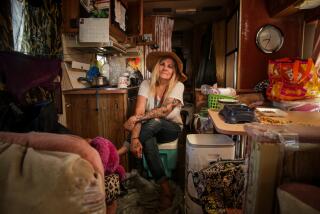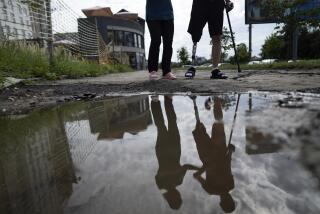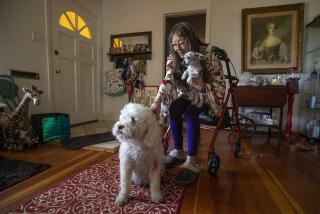Levity and Love Overcome Adversity for Amputee : Health: A toxic reaction--she blames a spider bite--cost Valerie Slimp her arms and legs, but not her spirit.
- Share via
MIRA LOMA — Valerie Slimp survived life-threatening toxic shock that ravaged her body and disfigured her nose, so this outing to Mervyn’s was a critical and symbolic step on her road to recovery.
Still, she had to ask her husband afterward, “Do you think anyone noticed my nose?”
“Sweetheart,” answered Randy Slimp with the kind of levity that has marked the couple’s steadfast relationship, “you don’t have any hands or legs. I don’t think anyone noticed your nose.”
And that’s how Valerie Slimp, 40, and her family are dealing these days with a trauma that, by all reasoning, should have yanked the rug out from under her life: with humor and perspective.
Last July 13, the mother of two watched in fear and disbelief as a sore rash on her left thigh--caused by a spider bite, she believes--began to spread. She collapsed in pain the next day.
After three months of drifting in and out of consciousness, she emerged as a quadrilateral amputee at the San Bernardino Medical Center. Her legs were cut off above the knees; her arms amputated just below the elbows. And, yes, the tip of her nose is dented; the infection had weakened cartilage that was then damaged by life-sustaining tubes.
Now, almost a year after her body’s wholesale rebellion against infection, Valerie Slimp is trying mightily to recapture her lifestyle despite almost incomprehensible handicaps.
Here is a woman whose first challenge was simply to balance her torso in a chair, fearful that if she fell, she could not catch herself.
Then she had to master what she calls the “butt scoot”--a propelling thrust of her trunk without falling over so she could move on a couch or on the floor without her wheelchair.
She learned how to turn over in bed and raise herself from a prone position with a mighty heave against gravity that punishes her every muscle.
The most recent milestone: fitting of prosthetic arms so she can eventually feed herself, comb her hair or--her most obsessive goal--go to the bathroom unassisted. For now, she wears the artificial arms for about an hour a day as she develops a new partnership with cables and levers.
Maybe in a year, she’ll be fitted with what doctors and prosthetic technicians matter-of-factly refer to as “stubbies” on her legs that will enable her to walk on plastic knees. Prosthetic legs and feet may come later.
Therapists--who say they’ve never before worked with a patient so physically destroyed--chart her progress with amazement and ponder her spirit. “She must have been an extraordinary woman before this, to have come through with this kind of attitude and perseverance,” says Becky Schmidt, a nurse at the Ballard Center for Rehabilitation in San Bernardino, where Slimp endures twice weekly physical and occupational therapy sessions.
She mixes unbridled determination and confidence with slapstick humor. When fitted with her new plastic-and-aluminum forearms with pincers for hands, her first act was to reach for her husband menacingly.
“I’ve been looking forward to pinching somebody,” she said, giggling. “You better watch out. I’m armed now.”
Slimp acknowledges that virtually every day will bring new challenges and confrontations, but she shrugs them off. When she’s instructed for the first time on how to twist her shoulders and back to manipulate the cable-driven levers that open and close her mechanical, two-digit hands, she smiles as others cringe.
“I’ve always been a gadget freak,” she said. “My head is filled with things I can now try!”
But it’s not coming easy.
When Valerie tries to direct a fork toward her mouth as if to feed herself, it heads instead toward her forehead. She looks around and smiles sheepishly. She tries it again, succeeds, and smiles widely this time.
Other patients try inconspicuously to watch these exercises. “They realize that their disability is nothing compared to what Valerie has to overcome,” Schmidt remarked. “It’s making them feel less sorry for themselves.”
Slimp says the only sorrow she feels is having put her husband and two children--Charlene, 12, and Stuart, 9--through a year of hell.
Valerie and Randy Slimp were moving from one house to another in this rural Riverside County community last July when, while shampooing the carpets, she felt her left leg stiffen and cramp.
The next day she felt exhausted and sick, barely able to drive home from the grocery store. The inside of her left thigh turned red, purple, then blue within hours. Feeling as if she was clobbered by the flu, she went to bed--and has no memory of being taken by Randy that night to Parkview Community Hospital in Riverside.
A doctor asked her husband if Valerie had been bitten by a spider, perhaps a black widow, and worked on that assumption.
Her fever worsened and she seemed to be reacting to toxic shock--a catastrophic reaction to infection in which circulation to the extremities is lost.
Valerie fought off the fever but after three weeks at Parkview, her limbs were turning black from lack of circulation despite twice-daily infusions of oxygen in a hyperbaric chamber.
She was transferred to the burn unit at San Bernardino County Medical Center for skin grafting, but her condition worsened.
“Her body had shut down parts of itself to save other parts in the face of overwhelming infection,” said Dr. David Vannix, who heads the burn unit. “As far as the body was concerned, it was willing to lose relatively nonessentials--the extremities.”
The affliction was something that doctors might see only once or twice in a career, Vannix said.
Randy stayed by his wife’s hospital bed, encouraging her even though he wasn’t sure she could hear him.
It became apparent to him, Randy said, that only amputations--if even that--would keep Valerie alive. “I don’t live in a fantasy world,” he said. “We talked about it in an almost detached manner, that she would have amputations.”
By that time, Randy’s home-based transmission parts business had fallen inactive, and the family was relying on Medi-Cal, Social Security and other sources to meet medical costs. To this day, he has no idea of the costs incurred.
A second episode of toxic shock struck Aug. 31, again plunging Valerie toward death and prompting doctors the next day--her daughter’s birthday--to amputate her left leg.
Because of pain-killing drugs, Valerie remembers nothing but hallucinations. She saw horses grazing outside her upper-floor window, skunks in the corridor and snakes in her bed. When she pulled back the sheets to check on the snakes, she discovered the amputation.
The doctors and Randy talked about the other amputations. They talked about quality of life, and about the possibility of death. Randy said his wife could deal with the amputations.
A family friend, Dajana Graham, was in the room when Valerie asked if additional amputations would be necessary.
“She started crying,” Graham said. “She was upset, but not how you’d expect. She said, ‘OK, if that’s what I’ve got to deal with.’ But there wasn’t hysteria, or ‘I don’t want to live anymore.’ ”
Her other leg and her two arms were amputated during the next two months.
Valerie’s first reality check came when she tried to pull up her sheets--and realized she couldn’t reach them.
Next came the discomfort of seeing herself on the television news, with the photographs of how she appeared before--with a slim face and flowing, wavy red hair. Now she was all but bald, and she cried.
She left the hospital in early January and took up temporary, full-time residence at the Ballard rehabilitation center.
“It was absolutely miraculous that she survived,” Vannix said. “I mentally had written her off as impossible to survive. That she survived and was getting back into the mainstream is incredible.”
On Feb. 12--her husband’s birthday--Valerie returned to the home where she had begun moving the previous summer.
Her recovery was a mix of depression, pain, excitement for getting better and frustration that the progress was slow. Her limbs were sore and the grafted skin was still healing. She feared falling. Randy and the kids learned to dress her and groom her.
And she developed a new theme for humor.
“I’m 4-feet tall now,” she laughs. “I tell Randy he finally has the petite wife he always wanted.”
Valerie forged her own recovery. With leather straps wrapped around her arms with Velcro, she would attach pencils with erasers to tap on a computer keyboard, resuming work on a fantasy novel. She attached paintbrushes to the straps and stroked canvas.
In time, she began receiving cards and letters from well-wishers. They thanked her for her courage. “One lady called me a blessing,” she said. Other amputees offered advice and encouragement.
Her daughter, Charlene, blamed herself for her mother’s illness, Valerie said. And young Stuart was pummeled with cruel wisecracks by schoolmates.
At one point, Valerie gave Randy permission to leave her.
“But he said he married me for better or for worse. We’ve been married for 14 years. The day Randy said ‘I do,’ he became the perfect husband.”
Instead of hiring an outsider to help in her daily care, Randy was trained for the job, and the family today is sustained by payments of $400 a month from the Riverside County Department of Social Services’ In-Home Supportive Services office and welfare payments of about $700 a month.
“Val asked me if I was embarrassed by her,” Randy said the other day. “I said no! I’m proud of her. She’s a survivor.”
Said Valerie: “I don’t see myself as a blessing. A role model, maybe, because I did survive this. Maybe now I can help others. I can be a sounding board.”
More to Read
Sign up for Essential California
The most important California stories and recommendations in your inbox every morning.
You may occasionally receive promotional content from the Los Angeles Times.













